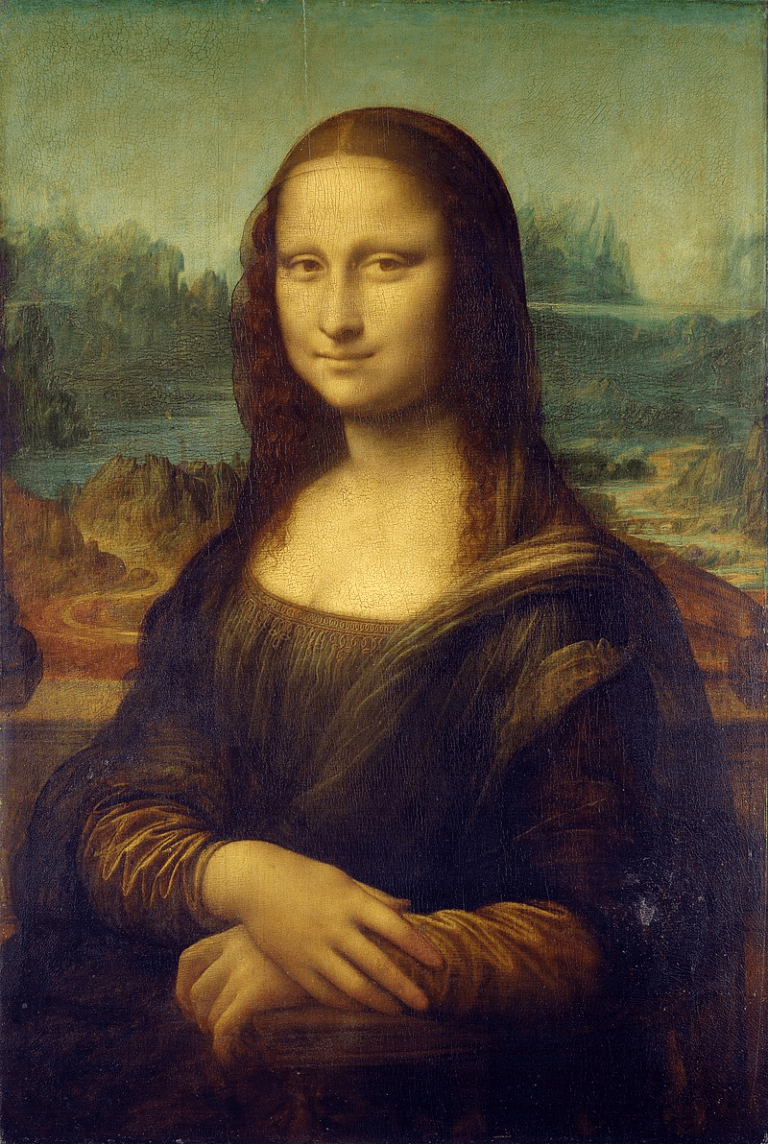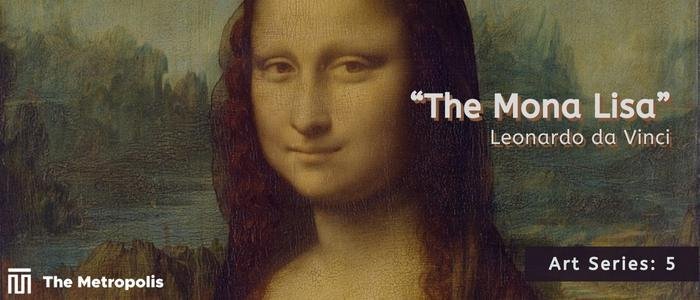Arya Tabassum –
The Mona Lisa, also known as La Gioconda or La Joconde, is a painting created by the Italian Renaissance artist, Leonardo da Vinci. It is one of the most famous paintings in the world and is considered one of the greatest masterpieces of Renaissance art. The enigmatic grin and understated mystery of the Mona Lisa have mesmerized viewers for centuries.

Leonardo da Vinci was an artist, inventor, and polymath who lived in the Italian Renaissance period. Along with his love of science, arithmetic, and anatomy, he was also renowned for his inventive painting methods. The Mona Lisa is regarded as one of his greatest creations due to its extraordinary beauty and technical mastery as well as the numerous interpretations that have been offered regarding its theme and meaning.
Leonardo used the sfumato painting method, which combines light and color to produce a delicate, ambient impression, to paint this 77 x 53 cm art in oil on a wooden panel. This method was particularly crucial for painting the background, which is full of hazy and softly-lit forests, streams, and landscapes. The woman in the portrait is seated on a throne and is looking at the viewer. She is one of the most recognizable and enigmatic figures in art history because of the many ways that her enigmatic smile and stare have been interpreted throughout time.
The identity of the Mona Lisa has been a subject of speculation for centuries with various theories. Some ideas contend that she was a noblewoman, a courtesan, or perhaps the artist’s mistress. Her identity as Lisa Gherardini, the affluent Florentine businessman Francesco del Giocondo’s wife, is the most frequently accepted idea. In honor of the birth of their second son, Francesco is thought to have ordered the image for his wife. In the half-length image, Lisa is shown seated in front of a bridge and mountains in the background. She has an enigmatic smile on her face and is dressed in Renaissance garb.
However, there have been allegations in recent years that the painting is a disguised self-portrait of Leonardo da Vinci. This theory is based on the notion that Leonardo’s mysterious smile and otherworldly stare are hallmarks of his artistic technique and that the painting is an expression of his personal feelings.
Another idea contends that Salai, Leonardo’s male lover, is shown in the Mona Lisa. This argument is based on the notion that the picture was intended to be a private communication between Leonardo and his lover, and that references to their relationship may be found throughout the picture, including the mysterious smile. This theory is still purely hypothetical because there is no hard data to back it up.
Over the years, numerous theories and interpretations have been made regarding the Mona Lisa. Some people have argued that the painting depicts the female soul, while others have argued that it depicts the divine feminine. Some people have even asserted that the painting contains unsolved codes and hidden messages.
One of the most fascinating aspects of the Mona Lisa is the enigmatic smile of Lisa. It has drawn numerous theories and interpretations and has been characterized as both mysterious and captivating. Some people think Lisa’s smile is a representation of her happiness, while others think it is a representation of a subtle smirk or a mask of sadness. Others still think that the smile is a representation of her enigma and mystery.
The enigmatic gaze of the woman has also been a source of speculation, with some suggesting that she is looking directly at the viewer, while others believe that she is looking off into the distance. Her enigmatic smile and gaze suggest a sense of mystery and otherness, which has made her one of the most iconic and mysterious figures in the history of art.
Some have interpreted the painting’s background as a representation of the artist’s idealized view of the natural world and the terrain. The soft, misty vistas, forests, and streams that make up the background are thought to represent the endless, enigmatic beauty of nature. A bridge in the painting’s gorgeous mountain backdrop is thought to represent the passage from the physical world to the spiritual world.
A lot of the background’s intricacies contribute to the painting’s overall tone and ambiance. For instance, the bridge is shown to be partially destroyed, which heightens the painting’s aura of mystery and intrigue.
The Mona Lisa is also considered to be a symbol of the art of painting itself, as well as a representation of the Renaissance period and the artists who lived during this time. Leonardo’s mastery of painting methods, his creative approach to art, and his enthusiasm for science and mathematics are all demonstrated in the artwork.
The Mona Lisa is known for its use of light and shadow. Leonardo was a master of chiaroscuro, the use of light and shadow to create the illusion of depth and volume in a painting. The Mona Lisa is no different, and the painter’s use of light and shadow gives the work a three-dimensional appearance that distinguishes it from other works from the same era.
The Mona Lisa was not widely known or appreciated until the 19th century when it was displayed at the Louvre Museum in Paris. The painting rose to fame during this period, becoming one of the most well-known pieces of art in history. Numerous efforts to steal the painting have been made, and in 1911 it was even taken from the Louvre. Two years later, it was found, and ever since then, it has been on display in the Louvre.
There has been substantial discussion around the Mona Lisa’s legitimacy. There have been allegations that the painting is a duplicate or that it has undergone restoration or alteration throughout the years, changing its original appearance. Some art historians contend that the artwork is not a real creation by Leonardo but rather a copy created by one of the master’s pupils.
Recent technological advancements have made it possible for art historians to examine the Mona Lisa in greater depth, which has improved our knowledge of its background and significance. A group of scientists examined the painting in 2016 using a multispectral camera and discovered that the original colors were distinct from the picture’s current appearance.
Additionally, the researchers found that the original hues have changed throughout time, probably as a result of damage and restoration efforts. The history of the picture has been clarified by this new information, which also helps us comprehend how it originally looked.
Regardless of the various interpretations and theories, the Mona Lisa remains one of the most famous and celebrated paintings in the world. It is a testament to the talent and genius of Leonardo da Vinci and serves as a symbol of the power of art to captivate and inspire. It has had a profound influence on artists throughout history. The enigmatic smile, the use of light and shadow, and the intricate details in the painting have inspired countless artists to recreate, interpret, and pay homage to the masterpiece.
The Mona Lisa had a significant impact on the Surrealist movement, among other things. The mysterious smile and air of mystery that the painting radiates served as an inspiration for artists like Salvador Dali and René Magritte, who used it to produce works that explore the subconscious and the surreal.
The Mona Lisa has also influenced the development of the Portrait genre, as many artists have sought to emulate Leonardo’s mastery in capturing the human form and expression. The Impressionist style, which aimed to capture the effects of light and color in the environment, was one artistic movement that was inspired by the oil paint blending technique employed in the painting.
Furthermore, the Mona Lisa has also become a symbol of high art and culture, inspiring countless imitations and parodies, and has appeared and been mentioned innumerable times in works of literature, music, film, and art in popular culture. The painting has become a cultural icon, representing beauty, mystery, and the human condition.
Many movies have featured the Mona Lisa, notably “Testament of Orpheus” by Jean Cocteau in 1960 and “Hail Mary” by Jean-Luc Godard in 1985. In Dan Brown’s 2003 novel “The Da Vinci Code”, the painting has been described as having a secret meaning that only a select few people are capable of deciphering. The Mona Lisa is portrayed in the novel as a representation of the divine feminine, and the mysterious smile is seen as a revelation from God.
Numerous tourist attractions, such as the Mona Lisa Room at the Louvre Museum, which is devoted to the painting and its background, have been created as a result of the Mona Lisa’s popularity. Visitors can view the Mona Lisa up close through a glass panel or admire it from a distance because the room is set up to highlight the picture in the best possible way. Numerous copies and imitations of the Mona Lisa have also been constructed, including an ice sculpture of the painting that was presented in London in 2018.
The Mona Lisa is a work of art, a portrayal of the complexities and ambiguities of human nature, and a symbol of femininity and beauty. It is evidence of Leonardo da Vinci’s talent and skill as well as of the Renaissance era’s art and culture. She has become one of the most recognizable and intriguing figures in art history thanks to her enigmatic smile and look, which have mesmerized audiences for ages.



